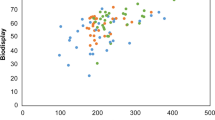Abstract
The aim of this in vivo study was to evaluate a skin reference electrode used with the microtouch method for measurements of intraoral pH. Registrations of plaque pH were made in ten healthy subjects before and up to 30 min after a mouth rinse with 10% sucrose. A microtouch electrode (Beetrode) was used in combination with two different half-cell reference electrodes: a skin silver-silver chloride plate or a glass capillary reference electrode. The skin electrode was placed on the subject’s forearm in combination with a conductive gel. The glass capillary electrode, together with one of the test subject’s fingers, was placed in a beaker with a 3 M KCl solution. High agreement between the two reference systems resulted in almost identical plaque-pH curves (r=0.97). The mean differences between the two systems at the different time points varied between −0.15 and +0.01 pH units, with an overall mean pH difference of 0.03 pH units. It can be concluded that the use of the skin reference electrode may very well replace the traditional reference electrode used in combination with a microtouch electrode for intraoral use.



Similar content being viewed by others
References
Baelum V, Fejerskov O, Küseler A (1994) Approximal plaque pH following topical applications of standard buffers in vivo. Caries Res 28:116–122
Fejerskov O, Scheie A, Manji F (1992) The effect of sucrose on plaque pH in the primary and permanent dentition of caries-inactive and active Kenyan children. J Dent Res 71:25–31
Harper DS, Abelsson DC, Jensen ME (1986) Plaque acidity models. J Dent Res 65:1503–1510
Huang GF, Guo MK (2000) Resting dental plaque values after repeated measurements at different sites in the oral cavity. Proc Natl Sci Counc ROC (B) 24:187–192
Imfeld T, Birkhed D, Lingström P (1995) Effect of urea in sugar-free chewing gums on pH recovery in human dental plaque evaluated with three different methods. Caries Research 29:172–180
Jensen ME, Schachtele C F (1983) Plaque pH measurement by different methods on the buccal and approximal surfaces of human teeth after a sucrose rinse. J Dent Res 62:1058–61
Kahrilas PJ, Quigley EMM (1996) Clinical esophageal pH recording: a technical review for practice guideline development. Gastroenterology 110:1982–1996
Küseler A, Baelum V, Fejerskov O, Heidmann J (1993) Accuracy and precision in vitro of Beetrode(r) microelectrodes used for intraoral pH measurements. Caries Res 27:183–190
Lingström P, Birkhed D (1994) Plaque pH and oral retention after consumption of starchy snack products at normal and low salivary secretion rate. Acta Odontol Scand 51:379–388
Lingström P, Imfeld T, Birkhed D (1993) Comparison of three different methods for measurement of plaque-pH in humans after consumption of soft bread and potato chips. J Dent Res 72:65–70
Millward A, Shaw L, Harrington E, Smith AJ (1997) Continuous monitoring of salivary flow rate and pH at the surface of the dentition following consumption of acidic beverages. Caries Res 31:44–49
Mühleman HR, Imfeld T (1981) Evaluation of food cariogenicity by plaque-pH-telemetry. In: Hefferren JJ, Koehler HM (eds) Foods, nutrition and dental health. Pathotox Publishers, Park Forest South, IL, pp 151–154
Neff D (1967) Acid production from different carbohydrate sources in human plaque in situ. Caries Res 1:78–87
Neuman RN (1995) Biopotential electrodes. In: Bronzino J (ed) The biomedical engineering handbook. CRC Press, FL, USA, pp 745–756
Nyvad B, Fejerskov O (1994) Development, structure and pH of dental plaque. In: Thylstrup A, Fejerskov O (eds) Textbook of clinical cariology. Munksgaard, Copenhagen pp 89–110
Scheie A, Fejerskov O, Lingström P, Birkhed D, Manji F (1992) Use of palladium touch microelectrodes under field conditions for in vivo assessment of dental plaque pH in children. Caries Res 26:44–52
Simpson A, Shaw L, Smith AJ (2001) Tooth surface pH during drinking of black tea. Br Dent J 190:374–376
Stephan RM (1940) Changes in hydrogen-ion concentration on tooth surfaces and in caries lesions. JADA 27:718–723
Acknowledgements
This study was supported by the County Council of Västerbotten, Sweden, and Colgate Palmolive A/S.
Author information
Authors and Affiliations
Corresponding author
Rights and permissions
About this article
Cite this article
Persson, A., Lingström, P., Bäcklund, T. et al. Evaluation of a skin reference electrode used for intraoral pH measurements in combination with a microtouch electrode. Clin Oral Invest 8, 172–175 (2004). https://doi.org/10.1007/s00784-004-0257-4
Received:
Accepted:
Published:
Issue Date:
DOI: https://doi.org/10.1007/s00784-004-0257-4




